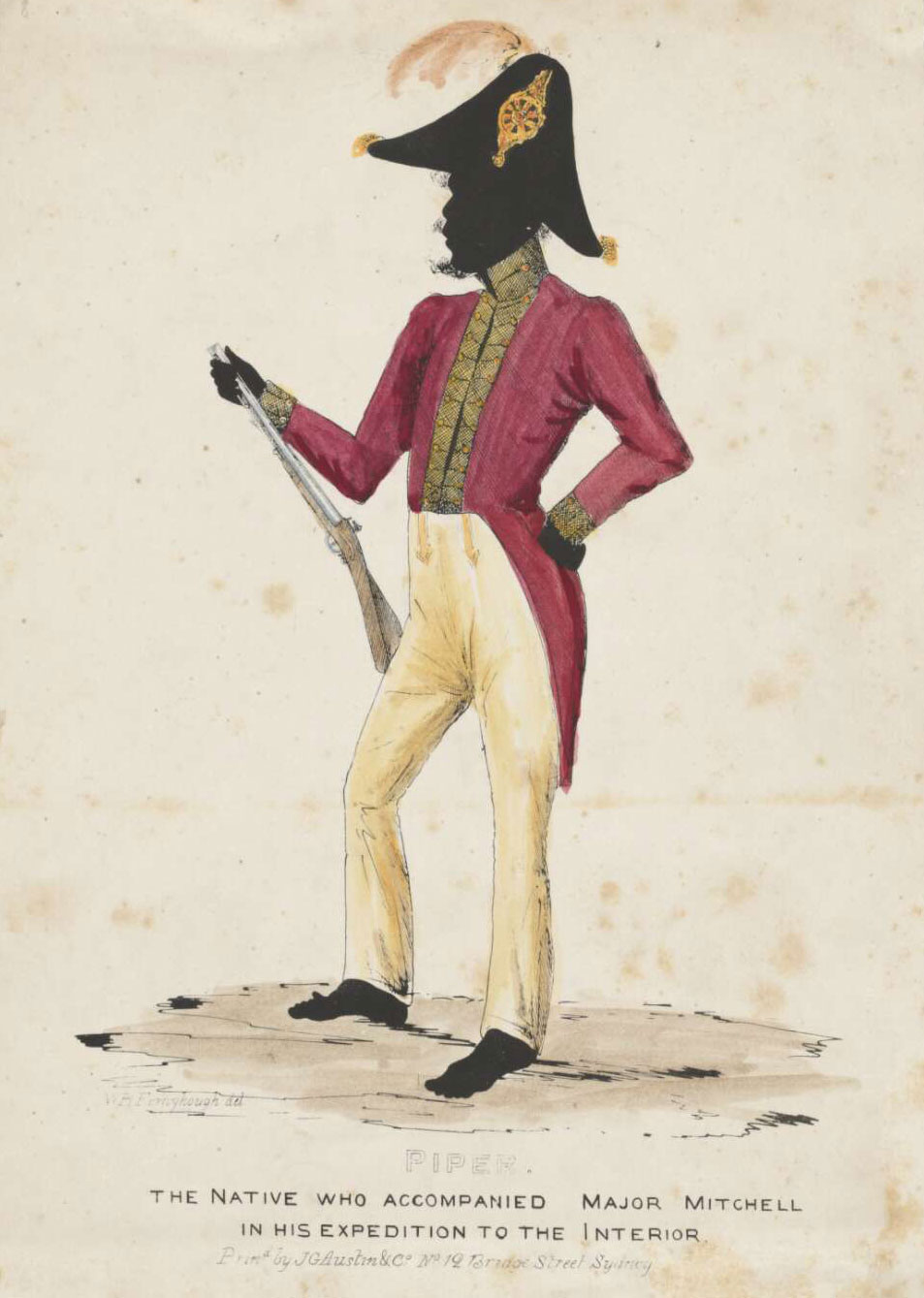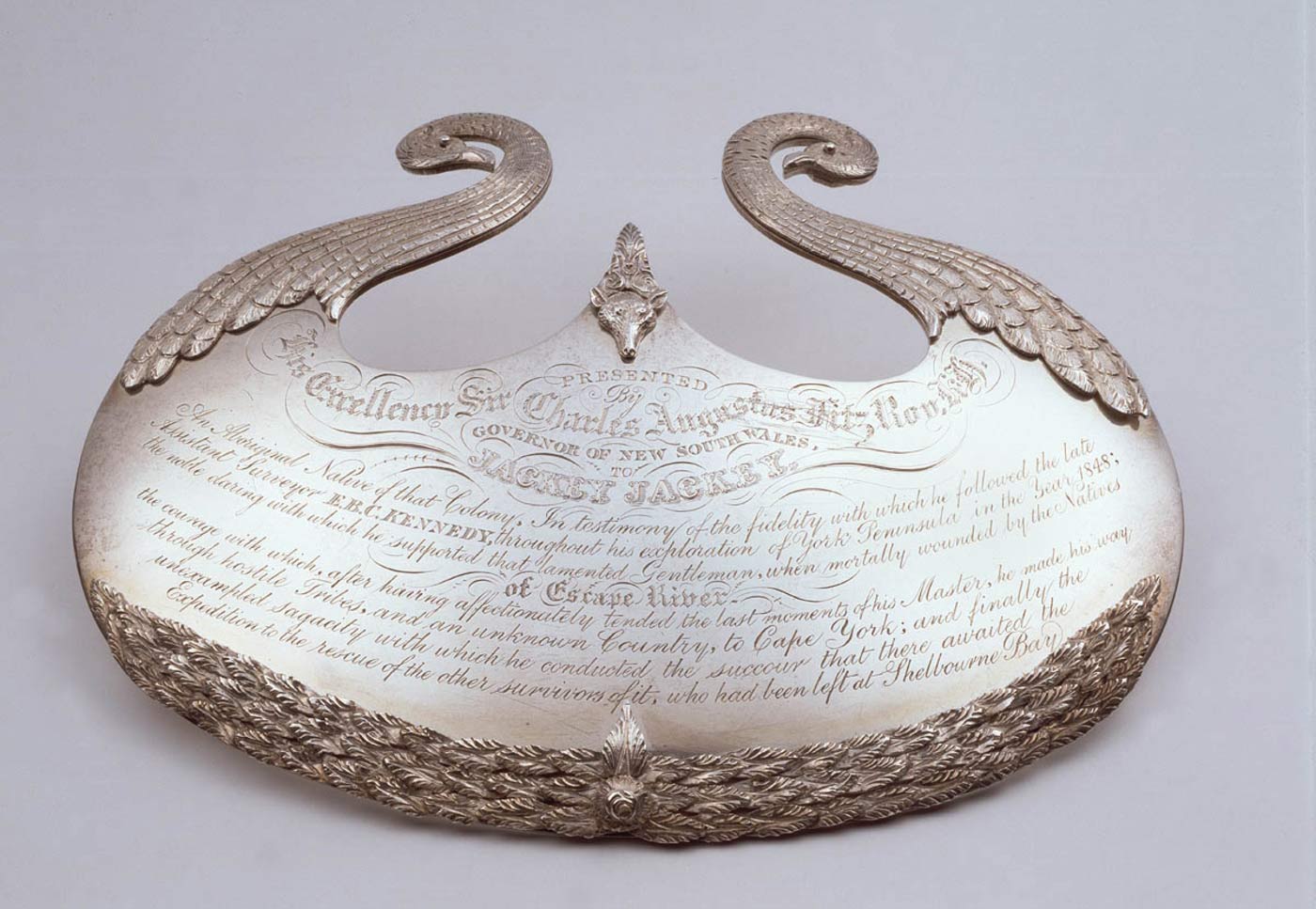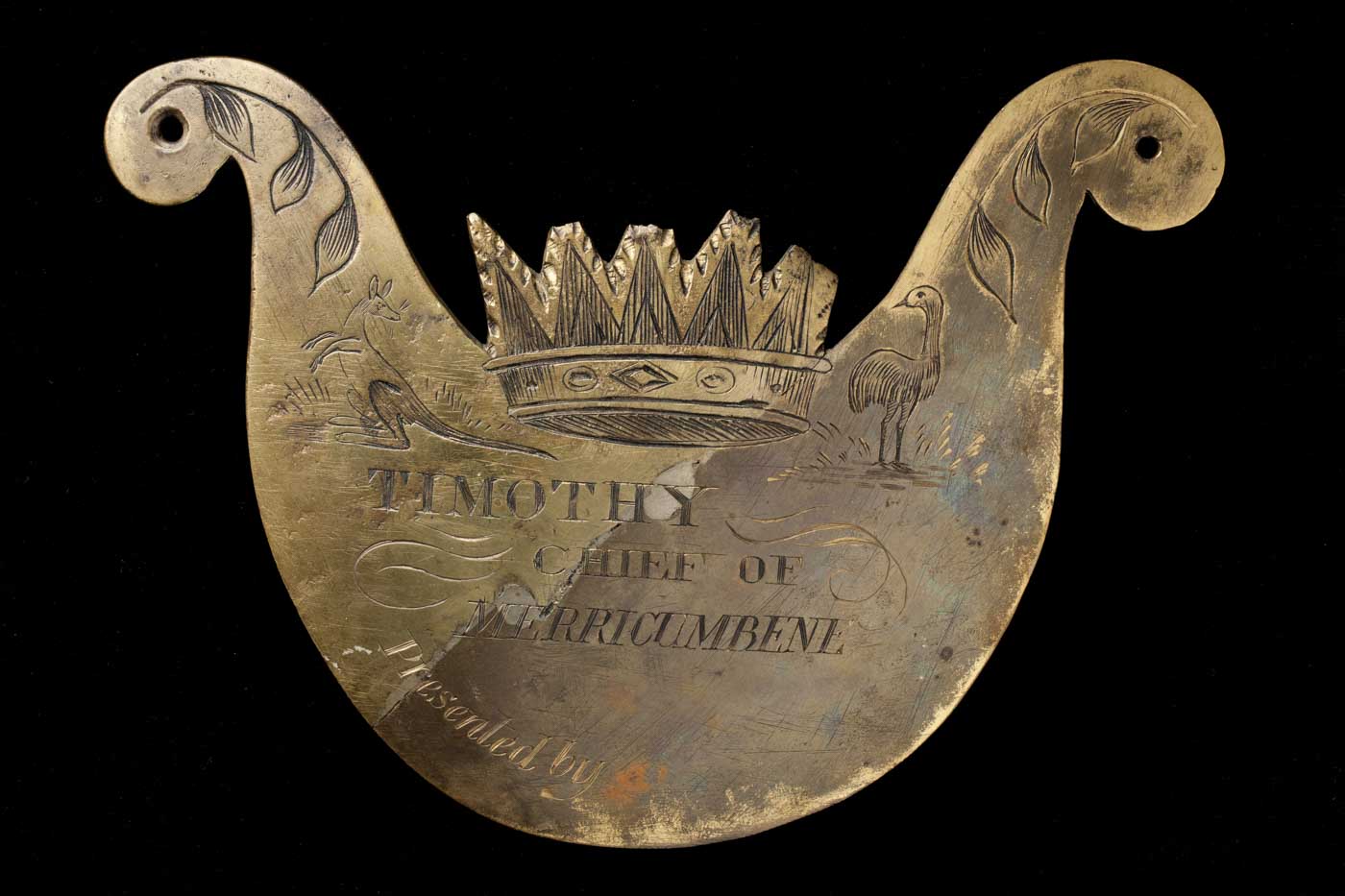Commemoration of heroic acts
Since the time of the earliest British settlement in Australia, many non-Aboriginal people have owed their lives and safety to selfless acts of heroism performed by Aboriginal people. Therefore it is not surprising that the well-established practice of honouring people with gorgets was extended to include rewards for bravery.
Most commonly the Aboriginal guides who accompanied exploring parties that ventured far from the boundaries of settlement were rewarded with a commemorative gorget. Another frequent act of heroism by Aboriginal people was the saving of non-Aboriginal people from drowning, often children who had fallen into rivers and waterholes or, most dangerous of all, the survivors of shipwrecks.
Aboriginal guides were included in all the 18th and 19th century exploring parties and were relied upon for the safety of the party when encountering strangers. Guides were often rewarded by either the expedition leader or the government for their services.
Jackey Jackey and the Kennedy expedition
One of the most famous cases was that of Jackey Jackey, a Sydney man who was the hero of Edmund Kennedy’s doomed expedition. For his outstanding courage in the face of extreme adversity, he was given the most elaborate and valuable of all known gorgets.
In 1848 Kennedy led an overland expedition which was to travel from Rockingham Bay to Cape York in far north Queensland. During the expedition, Kennedy came to regard Jackey Jackey with the highest esteem for his unmatchable bushcraft, reliability and steadfast friendship.
However, the expedition encountered insurmountable difficulties when nearing the Cape. Ten of the 13 members of the expedition died by accident or from exposure or were killed by hostile Aboriginal people.
Kennedy was fatally speared while making a dash for help to Cape York with Jackey Jackey in whose arms he died. Jackey Jackey, almost dead from exposure and fatigue, took the papers Kennedy instructed him to give to the governor and made the final journey to the supply ship Ariel anchored in the bay off Albany Island. On the ship he gave a moving account of the death of Kennedy and the demise of the expedition. [1]
In about 1851 Jackey Jackey was rewarded by the governor with a gorget which is the only one known to have been made from solid silver. It was a masterpiece by the firm Brush and MacDonnell and possibly their earliest piece. [2] The engraved eulogy testifies to Jackey Jackey’s loyalty and heroism in the face of tremendous hardship and danger:
Presented by His Excellency Sir Charles Augustus FitzRoy K.D. Governor of New South Wales, to Jackey Jackey, an Aboriginal native of that colony.
In testimony of the fidelity with which he followed the late Assistant Surveyor E.B.C. Kennedy, throughout the exploration of York Peninsula in the year 1848; the noble daring with which he supported that lamented gentleman, when mortally wounded by the Natives of Escape River, the courage with which after having affectionately tended the last moments of his Master, he made his way through hostile Tribes and an unknown Country, to Cape York; and finally the unexampled sagacity with which he conducted the succour that there awaited the Expedition to the rescue of the other survivors of it, who had been left at Shelbourne Bay. [3]

An earlier, equally famous but not so ill-fated expedition, led by Major Thomas Mitchell through the interior of the colony, was aided by an Aboriginal guide from Bathurst known as Piper. In 1831, at the end of the expedition, Piper was rewarded by Mitchell with an officer’s uniform and a brass gorget:
... Piper seemed to relish his share of triumph most, and certainly he well deserved the kindness he met with on all sides. I clothed him in my own red coat, and I gave him also a cocked hat and feather, which had once belonged to Governor Darling. His portrait, thus arrayed, soon appeared in the print-shops; an ingenius artist (Mr Fernyhough) having drawn his likeness very accurately.
Piper was just the sort of man to enjoy superlatively, all his newly acquired consequence. He carried his head high, for (as he now found) every body knew him, and not a few gave him money. With these donations, he purchased silk handkerchiefs, and wore them in his breast — gowns for his gins, for he at last had two — and, to his great credit, he abstained from any indulgence in intoxication, looking down, apparently with contempt on those wretched specimens of his race, who lead a gipsy life about Sydney.
... Piper was impatient to return to ‘his own country’, near Bathurst, and I fulfilled all the conditions of my contract with him, by allowing him an old firelock, blankets, &c., decorating him also with a brass plate, on which he was styled, not as usual ‘King’, for he said there were ‘too many kings already’, but Conqueror of the interior— surely a sufficient passport for him, among those most likely to read it, the good people of Bathurst. [4]
Colbee and the Middle Head rescue
Aboriginal people have always been formidable swimmers and their talents were often called upon to save drowning people. Without regard for their own safety many people made their rescues in flood-swollen rivers or high seas after a shipwreck.
As early as November 1790, the crew of a small fishing boat wrecked at Middle Head owed their lives to a Sydney man, Colbee, and his friends. They witnessed the incident, were the first to report it to the settlement and with a party of colonists saved the crew and recovered part of the vessel and the seine. [5]
Timothy, chief of Merricumbene
One of the gorgets held by the National Museum of Australia (collection number 1985.59.378) was given to an Aboriginal man, Timothy, chief of Merricumbene, for being one of a group of Aboriginal men who swam out to a sinking merchantman, saving life and cargo.
Edmund Milne who collected the gorget made some notes about the history of Timothy and his gorget:
Old residents, then alive, remembered the occasion of the presentation of the plate to Timothy for his valour in swimming with a lifeline to a stranded merchantman in the vicinity of Batemans Bay about 70 years before (that is about 1840). [6]
Piper and the Mitchell expedition
The government did not think the effort worth rewarding so a local naval captain took it upon himself to present each Aboriginal man involved with a gorget proclaiming his heroism.
Joseph Townsend in 1849 gave an account of the saving of a crew from a schooner off Batemans Bay by a group of Aboriginal men. They were all rewarded by a naval captain for their bravery. The stories and location match so closely that it can be safely said Townsend’s account provides the context in which Timothy won his award.
Timothy’s gorget was damaged and the dedication almost erased. However, it probably read ‘Presented by Capt Oldry’:
Some of the tribe to which the black belonged greatly distinguished themselves, three or four years since, by saving the crew of a schooner which was wrecked in the surf. The white bystanders stood aghast, and could not contrive means to render any assistance; but fifteen of the Aborigines formed a line, hand in hand, and went into the surf and saved all on board.
A benevolent individual residing near, a captain in the navy, made earnest application to the Governor, for a reward for these daring fellows; but the reply received was, that there were no funds at the disposal of the Government for such a purpose. This seems a hard case, when such immense sums have been realised by the sale of waste lands!
But Captain — did all he could to reward these men, by making them frequent presents of little comforts, and he presented to each ‘humanity man’ a brass plate, having attached to it a chain, by which to hang it round the neck. On each plate he caused to be engraved the name of the wearer, and a record of the good deed he and his comrades had done. This was the more generous, as the trading vessel that was cast away contained goods and stores belonging to himself, which were all irrecoverably lost.
The same gentleman is before alluded to as having, at a police office, pleaded the cause of a black held in captivity. He is an old and gallant officer, who has seen a great deal of hard service, and been more than once desperately wounded, and his noble nature ever prompted him to befriend the Aborigines. [7]
Footnotes
[1] E Beale, Kennedy, the Barcoo and Beyond, 1847: the Journals of Edmund Besley Court Kennedy and Alfred Allatson Turner with New Information on Kennedy’s Life, Blubber Head Press, Hobart, 1983, pp 66–70.
[2] JB Hawkins, Australian Silver 1800–1900, National Trust of Australia, Sydney, 1973, p. 32.
[3] S Mourot and P Jones, The Great South Land: Treasures of the Mitchell and Dixson libraries and Dixson Galleries, Sun Books, South Melbourne, 1979, p. 18 (plate on p. 60).
[4] T Mitchell, Three Expeditions into the Interior of Eastern Australia; with Descriptions of the Recently Explored Region of Australia Felix, and of the Present Colony of New South Wales, 2 volumes, 2nd revised edition, TW Boone, London, 1839, vol. 2, pp 338–39.
[5] D Collins, An Account of the English Colony in New South Wales, 2 volumes, AH and AW Reed, Sydney (1975), 1798, vol. 1, p. 117.
[6] E Milne Jr, Health Museum Breast Plates, list, manuscript, National Museum of Australia, EO Milne Collection file no 35/310, folio 165, nd.
[7] JP Townsend, Rambles and Observations in New South Wales With Sketches of Men and Manners, Notices of the Aborigines, Glimpses of Scenery, and some Hints to Emigrants, Chapman and Hall, London, 1849, pp 106–07.

